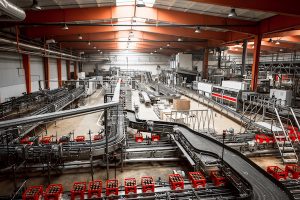A typical distribution center or warehouse receives stock of a variety of products from suppliers and store them until they are ready to be shipped to other wholesalers, retailers, or individual buyers.
Here are four benefits of logistics automation:
- Automated goods in processes: Incoming goods can be marked with barcodes and the automation system notified of the expected stock. On arrival, the goods can be scanned and thereby identified, and taken via conveyors, sortation systems, and automated cranes into an automatically assigned storage location.
- Automated Goods Retrieval for Orders: On receipt of orders, the automation system is able to immediately locate goods and retrieve them to a pick-face location.
- Automated dispatch processing: Combining knowledge of all orders placed at the warehouse the automation system can assign picked goods into dispatch units and then into outbound loads. Sortation systems and conveyors can then move these onto the outgoing trailers.
- If needed, repackaging to ensure proper protection for further distribution or to change the package format for specific retailers/customers.
Logistics automation systems comprise of a variety of hardware and software components:
Fixed machinery: Automated storage and retrieval systems that include:
- Cranes serve a variety of locations allowing many levels of stock to be stacked vertically, and allowing for higher storage densities and better space utilization than alternatives.
- In some systems automated guided vehicles move items to a human picker.
Conveyors:
- Containers can enter automated conveyors in one area of the warehouse and, either through hard-coded rules or data input, be moved to a selected destination.
- Vertical carousels based on a system using space optimization, similar to vending machines, but on a larger scale.
Sorting systems: Similar to conveyors but typically with higher capacity and able to divert containers more quickly. Typically used to distribute high volumes of small cartons to a large set of locations.
Four- to six-axis industrial robots, e.g. palleting robots, are used for palleting, depalleting, packaging, commissioning and order picking.
Typically, all of these will automatically identify and track containers using barcodes or, increasingly, RFID tags.
Motion check scales may be used to reject cases or individual products that are under or over their specified weight. They are often used in kitting conveyor lines to ensure all pieces belonging in the kit are present.
Mobile technology: Radio data terminals are handheld or truck-mounted terminals which connect by radio to logistics automation software and provide instructions to operators moving throughout the warehouse. Many also have barcode scanners to allow identification of containers more quickly and accurately than manual keyboard entry.
Software:
- Integration software: this provides overall control of the automation machinery and allows cranes to be connected to conveyors for seamless stock movements.
- Operational control software provides low-level decision making, such as where to store incoming containers, and where to retrieve them when requested.
- Business control software provides higher-level functionality, such as identification of incoming deliveries/stock, scheduling order fulfillment, and assignment of stock to outgoing trailers.
With the industry standard moving more towards robotic driven systems, logistics automation systems will continue to be developed.
If you are designing a system that reads barcodes, a robotic system, handheld devices, etc., we will ensure that the precision lens you pick meets the standards which you expect. We offer a wide recision lens you pick meets the standards which you expect.